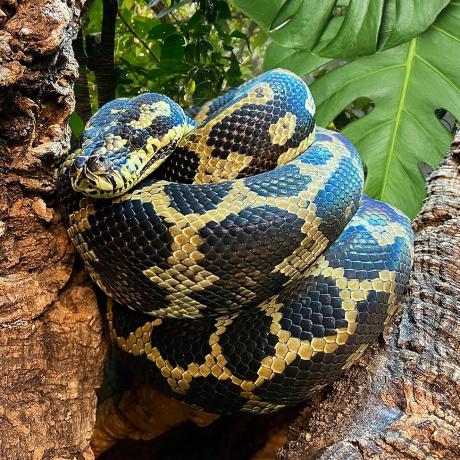

Carpet Pythons are large snakes varying in size depending on locality from four to twelve feet in length and weighing up to 15kg.
Coastal Carpet Pythons are a large muscular species within this genus, growing to an impressive size of anywhere up to 4 metres and weighing up to 15kg and can live up to around 30 years. Their colour is variable and can range from olive to brown and grey, yellow-cream, gold with dark olive, grey and black patterning. Over the years, various morphs have been produced, though beautiful in their own right, the wild type colouring is (in our opinion) the most stunning. They have large heads with impressive thermoreceptive labial pits, making them excellent predators both on the ground and in the treetops.
The species is found throughout mainland Australia, Western New Guinea, Papua New Guinea. They thrive in rainforests and woodland areas, but are also found in grassland areas and because of their highly adaptive nature they are also found in built up areas.
As with many larger snake species, they require a lot of space, time and patience to tame down. Carpet Pythons are notoriously food driven and will often strike before realising there is no food present. For more experienced keepers who understand how to read a snakes body language and are confident in handling, these snakes will generally calm down. We ask that you seriously consider whether you can provide the animal with everything it requires for the duration of its life. Larger snakes do not generally make good pets for families with young children, as even the most docile animal has the potential of causing damage should it strike. It is our responsibility to ensure that you are well informed with regards to knowing what keeping a large snake entails, we would rather put people off buying than sell these animals to unsuitable or irresponsible owners and have them being rehomed or dumped.
Carpet Pythons are semi arboreal, which means that wherever you house them they will utilise vertical space readily. The vivarium needs to be of considerable measurements, for an adult the minimum space required is something near to 2.1 x 1.0 x 1.2m (7ft x 3ft x 4ft). For juveniles up to 1m long, a 120 x 60 x 60cm (4 x 2 x 2ft) vivarium is the absolute minimum - though taller would be better. From an enrichment viewpoint, most Carpet Pythons will require plenty of cork bark and branches to create multiple levels, plants and hiding caves will also be readily enjoyed by these intelligent creatures.
We recommend using a Coir based substrate mixed with orchid bark maintained at around 50-60% humidity. They sometimes enjoy wallowing in water, provision of a large enough dish or pool to soak in will be used. For adults in custom built enclosures, many owners opt to add in a pool with drainage underneath to make cleaning easier.
Heating the enclosure adequately is extremely important, as these snakes come from Australia. As with all reptiles, a temperature gradient is essential so that the animal can properly regulate its body temperature (thermoregulate) and digest foods properly.
The most common method for heating a large enclosure is to use a guarded basking bulb on a thermostat, often combined with Deep Heat Projectors or Halogens (again, controlled by thermostats.) For larger enclosures it is easier to achieve the desired temperature gradient which ideally needs to range from around 22°C cool end, to a basking area of 32°C. At night time the lights should be turned off, or if room temperatures are lower than 20°C, a ceramic bulb (non light emitting) on a thermostat should be set to ensure the temperature does not drop too low.
With regard to UVB lighting, there is still a lot of outdated information suggesting that snakes do not require UVB but they absolutely do. Carpet Pythons benefit significantly from access to UVB, requiring a Ferguson Zone of 2. UVB exposure plays a vital role from the synthesis of vitamin D3 and the absorption of calcium, to the regulation of circadian rhythm, physical and mental behaviour and activity levels.
Feed your Carpet Python on defrosted rodents. The biggest issue with Carpet Pythons is that they are naturally greedy! It is easy to fall into the trap of overfeeding, and as with any species, growing large too quickly and becoming obese can result in health complications and ultimately a premature death in extreme cases. The size of food given depends on the size of the snake, this shouldn’t be any larger than the widest part of the reptiles body. Young Carpet Pythons should be fed every 7-10 days, older Carpet Pythons every 10-14 days and adults should be fed every 3 weeks. In the wild Carpet Pythons will often feed on birds, so offering an adult frozen thawed Quail will be readily taken. We suggest avoiding chicks due to the low nutritional value, adult birds are more nutrient rich. It is best to make a log of when your snake eats and sheds its skin, this helps to spot any patterns or behaviours linked to the feeding cycle.
Please note: Our team reserves the right to refuse sale of this animal if we feel that the long term wellbeing or welfare is in question. Large reptiles come with challenges; from temperament to housing, equipment and upkeep costs. It is our responsibility to the animal to determine your experience levels and suitability; we apologise if this offends you, but our strict policies are in place for the protection of the animal to ensure it has the best possible life - animal welfare always comes before profit.